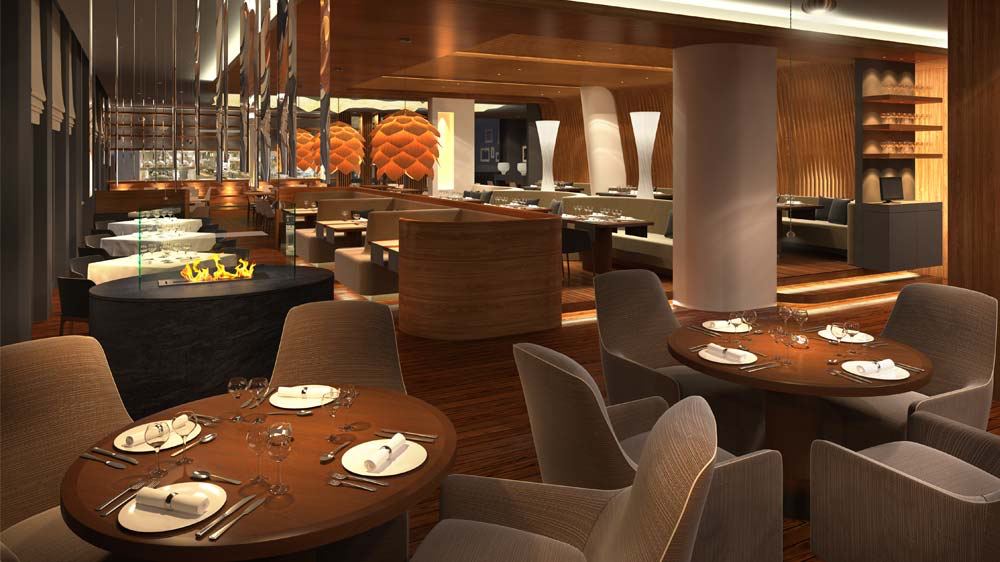In the competitive restaurant industry, it’s crucial for businesses to find creative and effective ways to stand out from the crowd and attract new customers. This is where restaurant advertising comes in. By promoting their brand, menu, and services through a variety of marketing channels, restaurants can create a strong presence in their local market and increase their customer base. In this article, we’ll take a closer look at what restaurant advertising is and explore some of the key strategies and tactics used by successful eateries to drive sales and revenue.
Restaurant advertising is like a secret sauce that makes your eatery stand out from the crowd. It’s the magic wand that brings in hungry customers to savor your delectable dishes. It’s like a delicious aroma that tantalizes taste buds and makes them crave your food. In short, restaurant advertising is the flamboyant chef’s hat that announces to the world that your eatery is the place to be for a scrumptious dining experience.
So, Why is restaurant advertising important?
Restaurant advertising is important for several reasons, and it plays a critical role in attracting new customers, retaining existing ones, and building a brand image. In today’s competitive business environment, it is essential for restaurants to promote themselves to remain relevant and successful. Here are some of the reasons why restaurant advertising is so important:
Picture this: You’re strolling down the street, feeling a bit peckish and in the mood for a delicious meal. Suddenly, you see a sign that catches your eye – it’s the logo of a restaurant you’ve never tried before. But wait, you remember seeing an ad for this place somewhere. Ah yes, that’s right! The power of advertising has worked its magic, and now this restaurant is on your radar.
Creating brand awareness is like introducing yourself to the world – you want to make a good impression and stand out from the crowd. That’s where advertising comes in handy for restaurants. By showcasing their unique features, specialties, and values, restaurants can differentiate themselves from their competitors and capture the attention of potential customers.
Think about it – if every restaurant had the same menu, ambiance, and customer service, how would you choose where to eat? Advertising helps restaurants highlight what makes them special and why they’re worth trying out. Maybe they have a signature dish that’s to die for, or perhaps they use locally-sourced ingredients that align with your values. Whatever it may be, advertising helps bring these distinguishing factors to the forefront and creates a positive image in the minds of potential customers.
Similarly, Imagine You’ve just opened up a restaurant, and you’re eager to spread the word about your delicious cuisine and unparalleled customer service. But how do you entice potential customers to take a chance on your eatery? The answer lies in advertising!
Advertising is like a magician’s wand that can magically transport your restaurant’s menu, ambiance, location, and customer service straight to the hearts and stomachs of new customers. By showcasing your restaurant’s unique features and tantalizing offerings through clever ads and catchy slogans, you can create a buzz that will leave people salivating for more.
You definitely could have the most mouth-watering menu items in the world, but if no one knows about them, it’s like a party with no guests. That’s where advertising comes in – it’s like a personal invitation to a culinary adventure that people won’t want to miss.
Next to add spice effective advertising campaigns for restaurants can help skyrocket their revenue. By grabbing the attention of potential customers and encouraging them to visit, these campaigns can make them more willing to spend their dough on scrumptious food and delightful experiences. Plus, a well-executed advertising campaign can lead to the magical phenomenon of word-of-mouth marketing, where satisfied customers will sing praises of the restaurant to their friends and family, bringing even more business to the table.
In today’s competitive market, restaurants need to stay ahead of their competition to survive. Effective advertising can help restaurants stay top of mind among consumers and remain competitive with other restaurants in their area.
Now that you Know what restaurant advertising is you may have come to realize that there are certain principles that restaurants follow to achieve their advertising goals. These principles can guide restaurants in creating effective advertising campaigns that successfully reach and engage their target audience.
1. Know your target audience:
Before creating an advertising campaign, restaurants must identify their target audience. This includes factors such as age, gender, income level, interests, and location. By understanding the demographics of their potential customers, restaurants can tailor their messaging and advertising channels to reach them effectively.
2. Focus on your unique selling proposition (USP):
Every restaurant has something that sets it apart from its competitors. Whether it’s a unique menu item, a particular ambiance, or a commitment to sustainability, restaurants must identify their USP and highlight it in their advertising. This helps differentiate the restaurant from others and creates a strong brand image.
3. Choose the right advertising channels:
There are numerous advertising channels available for restaurants, such as social media, email marketing, outdoor billboards, and television ads. To make the most of their advertising budget, restaurants must choose the channels that are most likely to reach their target audience effectively.
4. Create compelling visuals and messaging:
The visuals and messaging used in restaurant advertising campaigns must be eye-catching, memorable, and persuasive. Restaurants should use high-quality images of their food, decor, and ambiance and create messaging that communicates their USP in a clear and concise way.
5. Offer promotions:
Offering promotions is an effective way to attract new customers and retain existing ones. Restaurants can use advertising to promote special deals, discounts, loyalty programs, or seasonal offerings.
6. Monitor and measure the results:
To assess the effectiveness of their advertising campaigns, restaurants must track and measure the results. This includes monitoring metrics such as website traffic, social media engagement, and customer feedback. By analyzing the results, restaurants can make adjustments to their advertising strategy and improve their future campaigns.
We’ll let you in on a secret did you know there are advertising methods that are not commonly known and using them can be your added advantage?
1. Geo-fencing advertising:
Geo-fencing advertising involves creating a virtual boundary around a physical location, such as a restaurant, and targeting ads to mobile devices within that area. This type of advertising can be effective in reaching customers who are in the vicinity of the restaurant and may be looking for a place to eat.
2. In-app advertising:
In-app advertising involves placing ads within mobile apps that are relevant to the restaurant’s target audience. For example, a restaurant could advertise on a food delivery app or a popular restaurant review app.
3. Influencer marketing:
Influencer marketing involves partnering with social media influencers who have a large following and are relevant to the restaurant’s target audience. The influencer can promote the restaurant through their social media channels, such as Instagram or YouTube, and create content that showcases the restaurant’s menu or ambiance.
4. Guerilla marketing:
Guerilla marketing involves creating unconventional advertising campaigns that are designed to grab people’s attention and create buzz. For example, a restaurant could create a pop-up dining experience in an unexpected location or use street art to promote their brand.
5. Cross-promotion:
Cross-promotion involves partnering with other businesses or brands to promote each other. For example, a restaurant could partner with a local hotel to offer a discount package for visitors, or they could offer a special deal for customers who shop at a nearby store.
Our list of effective restaurant advertising methods is not yet complete! In addition to here are proven advertising methods that have consistently delivered positive results for restaurants:
1. Social media advertising:
Social media advertising is a highly effective way to reach potential customers and engage with them on popular platforms like Facebook, Instagram, and Twitter. Restaurants can use social media ads to promote their menu items, special deals, and events to specific target audiences based on demographics and interests.
2. Email marketing:
Email marketing is a cost-effective way to promote a restaurant’s menu items, events, and promotions to a large audience. Restaurants can collect email addresses from customers and send targeted emails based on their interests and preferences.
3. Search engine marketing:
Search engine marketing involves using search engines like Google to promote a restaurant’s website and menu items. Restaurants can use paid search ads and search engine optimization (SEO) techniques to appear higher in search engine results pages (SERPs) for relevant keywords and phrases.
4. Local print advertising:
Local print advertising, such as in community newspapers and magazines, can be an effective way to reach a targeted audience within a specific geographic location. Restaurants can use print ads to promote their menu items, events, and special deals to local residents.
5. Sponsorship and partnerships:
Sponsoring local events or partnering with other businesses can be an effective way to promote a restaurant’s brand and attract new customers. For example, a restaurant could sponsor a local charity event or partner with a nearby theater to offer a dinner-and-show package.
We also have a secret method in our books that we’re willing to share with you. Did you know that PR is one of the most effective and oldest advertising methods for restaurants?
With PR, restaurants can gain popularity by getting media coverage, rubbing shoulders with influencers and bloggers, and being a social media darling. They can be the talk of the town by securing coverage in magazines and newspapers, and participating in food festivals.
By building a positive reputation and getting noticed, PR can help restaurants find new customers who haven’t discovered them yet. PR can also help restaurants enhance their credibility by showing off their awards and positive reviews.
But PR isn’t just about being the belle of the ball. It can also help restaurants build relationships with their customers by chatting with them on social media, responding to reviews, and creating a sense of community. It’s like having a best friend who always has your back.
Although the cost of PR for restaurants in India can vary depending on the scope of work, the size of the PR agency, and the level of experience of the PR professionals involved. Generally, PR agencies in India charge a retainer fee that can start ranging from INR 10,000 per month and vary, depending on the agency’s reputation and expertise.
While PR can be a valuable investment for restaurants, it’s important to be mindful of your spending to ensure that you’re getting the most value for your money.
Here’s how to be mindful while spending on PR:
1. Set clear goals:
Before investing in PR, it’s important to set clear goals for what you want to achieve. This can help you focus your efforts and ensure that you’re getting the most value for your money.
2. Work with a reputable agency:
Choose a PR agency that has experience working with restaurants and a proven track record of success. Research the agency’s reputation, read reviews, and ask for references before making a decision.
3. Negotiate fees:
Don’t be afraid to negotiate fees with your PR agency. Ask for a breakdown of costs and negotiate a fee that fits within your budget.
4. Be strategic:
Focus your PR efforts on activities that are likely to have the biggest impact on your business. For example, if you’re a new restaurant, focus on building awareness and attracting new customers.
5. Measure your results:
Monitor the impact of your PR efforts by tracking media coverage, social media engagement, and other metrics. This can help you evaluate the effectiveness of your PR campaign and make adjustments as needed.
By being mindful of your spending and working with a reputable agency, you can get the most value out of your PR investment and achieve your goals for promoting your restaurant.
While there are many different types of restaurant advertising methods available, the ones mentioned above are essential to any successful marketing strategy. By following the principles of effective restaurant advertising and utilizing proven methods such as social media advertising, email marketing, search engine marketing, local print advertising, and sponsorships and partnerships, restaurants can attract new customers, retain existing ones, and increase revenue.
It’s important to stay up to date with new trends and technologies in the industry, and to be open to experimenting with new advertising methods to keep customers engaged and interested. By incorporating these principles and methods into their advertising strategies, restaurants can create impactful and successful campaigns that help them stand out in a competitive market.









Leave a Reply